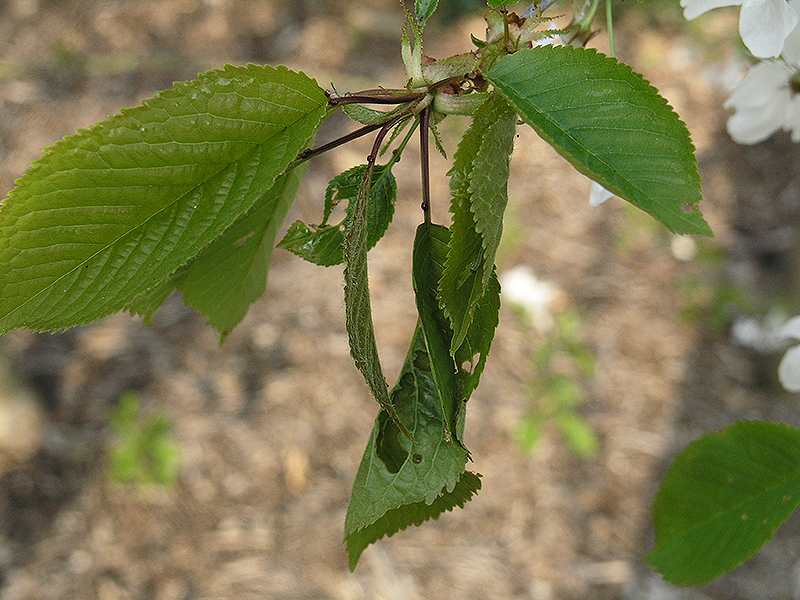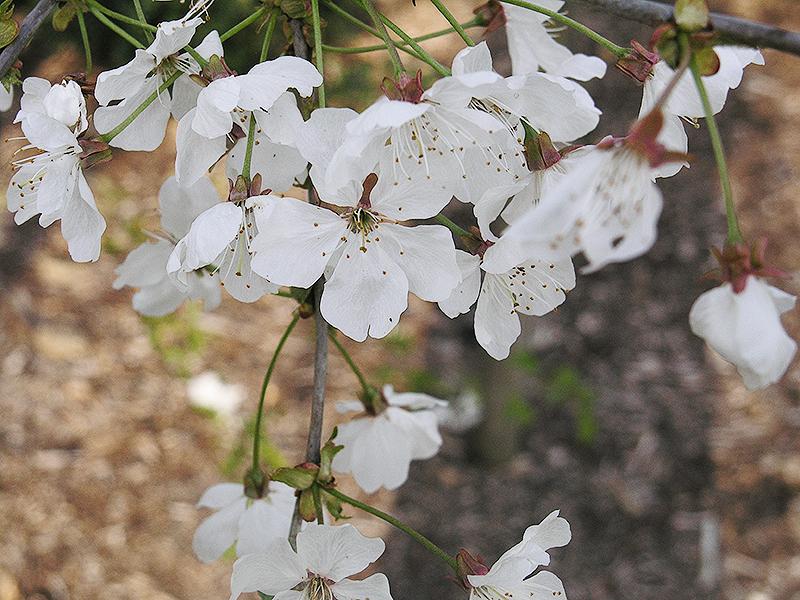
Woody > Prunus > Prunus avium > Prunus avium
Prunus avium
Sweet or Mazzard Cherry
Mike's
Opinion


"
A rather large, hardy fruiting tree that is wonderful in bloom with attractive autumn colour; ot often seen in North America.
Michael Pascoe, NDP., ODH., CLT., MSc. (Plant Conservation)
"
| Family |
| Rosaceae |
| Genus |
| Prunus |
| Species |
| avium |
| Category |
| Woody |
| Type |
| Tree (deciduous) |
| Pronunciation |
| USDA Hardiness Zone |
| 3 - 8 |
| Canadian Hardiness Zone |
| 1a - 8a |
| RHS Hardiness Zone |
| H7 - H4 |
| Temperature (°C) |
| (-37) - (-7) |
| Temperature (°F) |
| (-35) - 20 |
| Height |
| 10 m |
| Spread |
| 4 m |
Photographs
Description and Growing Information
Flowering Period
| General Description |
| Is a deciduous tree that resembles brown-red wood. Its leaves are simple, toothed on the margin, and has two small glands at the base of its blade. The fruit is, yellow or red, and has a very large pit. |
| Cultivation |
| Requires a well-drained moisture retentive soil. Succeeds in light shade but fruits better in a sunny position. Thrives in a loamy soil, doing well on limestone. A very ornamental plant, it is fast growing on deep moist soils but is shallow rooting. |
| Shape |
| This tree has a loosely pyramidal shape. |
| Growth |
| Fast |
| ID Characteristic |
| A lot of these trees are found in Germany. This plant is known for its beautiful white flowers, green leaf colour during the summer and its bronze/gold/yellow colour in the autumn. Flowers in several umbals. Fruit is red-black. |
| Pests |
| Bacterial diseases: bacteria canker; Fungal Diseases: alternaria rot; Genetic Disorders: crinkle; Viral diseases: leaf roll; phytoplasmal disease, X-disease. Plum Pox: Symptoms may be confused with other diseases/disorders such as nutrient deficiencies or pesticide injuries. PPV symptoms can occur on leaves, flowers and/or fruit. Faint yellow rings or lines may be found on the leaves. PPV generally does not cause plant mortality however, can reduce the plant productivity and longevity. How to Reduce the Spread and Impact of PPV: 1. Propagate vulnerable Prunus trees and shrubs outside of the affected area a. Isolation is important to protect clean plants from future spread of the disease. b. Propagating and growing vulnerable plants away from the virus-infected area reduce the likelihood of the disease spreading any further. This should be as far away from the quarantined area and any potential sources of the virus. 2. Propagate Prunus plants with virus-free Budwood and Rootstock from virus tested mother trees a. This eliminates the propagation link for viral diseases. 3. Inspect vulnerable Prunus for symptoms a. All Prunus shrubs and trees should be visually inspected for symptoms at lease twice per year and conducted by trained personnel familiar with the virus. b. Any plants found to be infected should not be moved or sold and must be reported to the Canadian Food Inspection Agency immediately. c. Inspections should not be conducted in periods of hot weather (temperatures over 30?C). 4. Manage aphid vectors a. Aphids are extremely attracted to suckers (vegetative shoots at the base of the tree), these should be removed to avoid aphid colonization, feeding or migration. 5. Plant tolerant and resistant varieties a. When available, grow plum pox tolerant or resistant Prunus varieties. |
| Habitat |
| Native to Europe and Asia. |
| Bark/Stem Description |
| The bark is smooth purple-brown with prominent horizontal grey-brown lenticels on young trees, becoming thick dark black-brown and fissured on old trees. |
| Flower/Leaf Bud Description |
| Spur shoots present with multiple terminal buds. |
| Leaf Description |
| Simple, oblongovate, 0.65–1.95 cm long, 0.5–5 cm wide, acuminate, unequally serrated, dull dark green and often slightly rugose above, more or less pubescent beneath and of a soft texture. |
| Flower Description |
| Fragrant white flowers — 1.5–3.5 cm — appear individually or in 3–5 flowered umbals in the spring, slightly before the foliage emerges. Flowers are accompanied by small sweet red to black cherries which evolve in early summer. |
| Fruit Description |
| The fruit is a drupe — 1–2 cm in diameter (larger in some cultivated selections), bright red to dark purple when mature in mid summer, edible, variably sweet to somewhat astringent and bitter to eat fresh. |
| Colour Description |
| Oval, dull, dark green leaves. In autumn, the leaves turn orange, pink or red before falling. |
| Texture Description |
| The bark is smooth, and leaves are more or less pubescent. |
| Notable Specimens |
| The Arnold Arboretum, Jamaica Plain, Massachussetts. |
| Propagation |
| Place stored seed in a cold frame as early in the year as possible. Protect the seed from mice etc. The seed can be rather slow, sometimes taking 18 months to sprout. Prick out the seedlings into individual pots when they are large enough to handle. |

